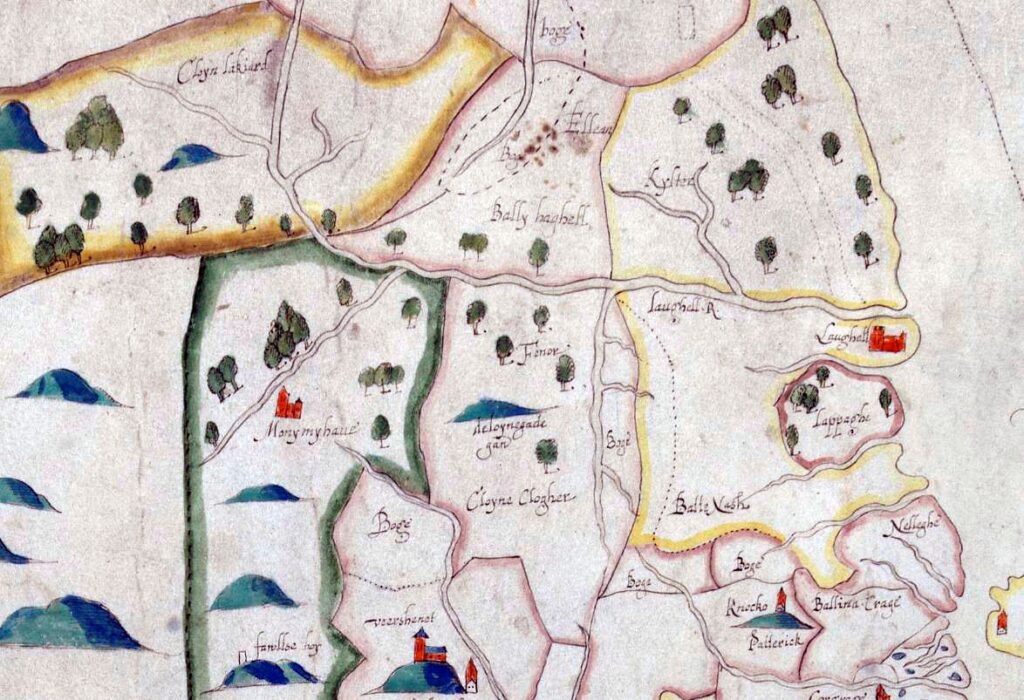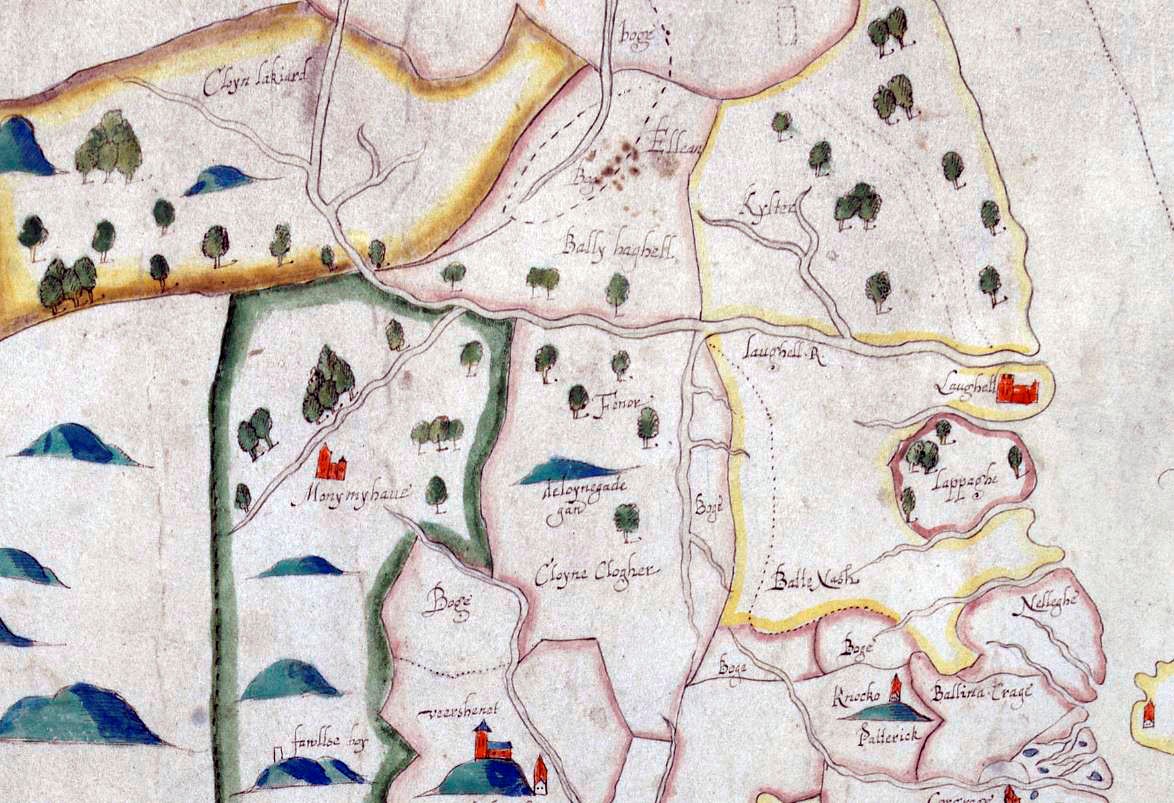by Brendan Doyle
Áth na gCorp
The Old Burial Ground of Áth na gCorp in Clounlehard, Ballyhahill (Monument: LI027-001),(Location co-ordinates: 52.523833 -9.203189), (Eircode: V94 HFY6) is the site where four hundred men, women and children were slaughtered by Elizabethan forces on Wednesday, 12 March 1580 during a search for the then Earl of Desmond, Gerald FitzGerald, during the Second Desmond Rebellion
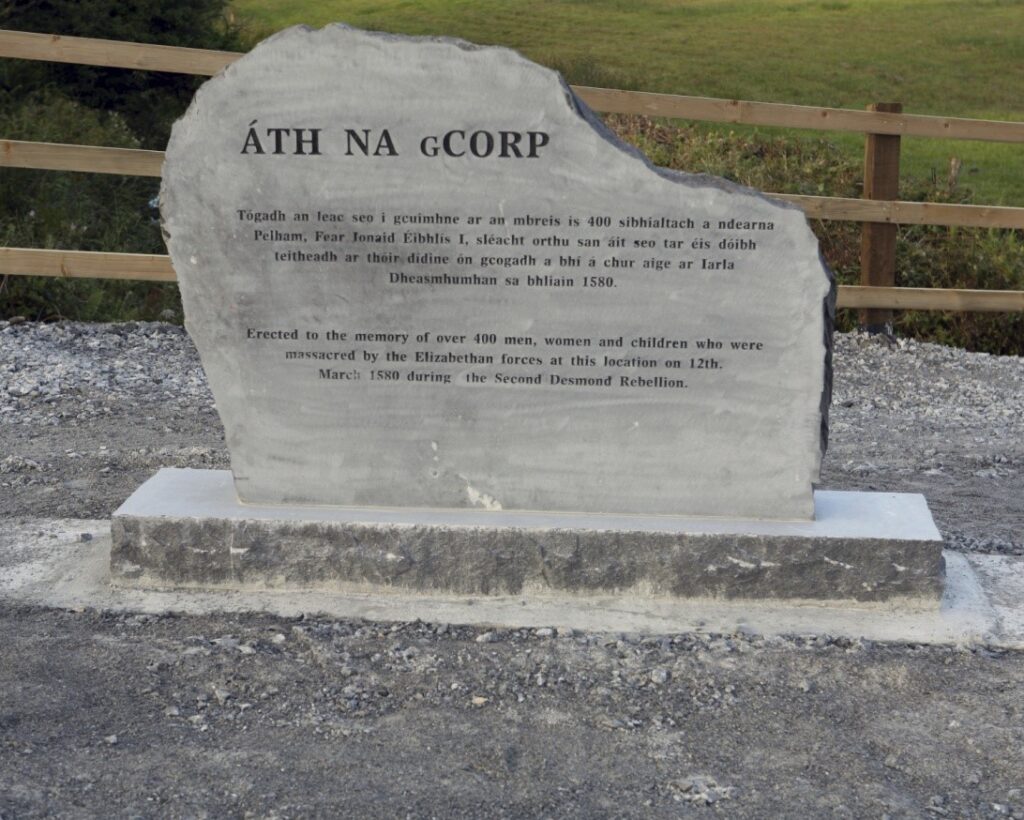
The Second Desmond Rebellion (1579–1583)
The Second Desmond Rebellion was sparked when James FitzMaurice launched an invasion of Munster in 1579. During his exile in Europe, he had declared himself as a soldier of the Counter-Reformation, arguing that following the Pope’s excommunication of Elizabeth I, Irish Catholics did not owe loyalty to a heretic monarch. The Pope granted FitzMaurice an indulgence and supplied him with troops and money. FitzMaurice landed at Smerwick, near Dingle on 18 July 1579 with a small force of Spanish and Italian troops. He was joined on 1 August by John of Desmond, a brother of the earl, who had a large following among his kinsmen and the disaffected swordsmen of Munster. Other Gaelic clans and Old English families also joined in the rebellion.
Gerald, the Earl of Desmond, initially resisted the call of the rebels and tried to remain neutral. But he gave in once the authorities had proclaimed him a traitor on 2 November 1579. He joined the rebellion by sacking Youghal (on 13 November) and Kinsale, and devastated the country of the English and their allies.
Sir William Pelham arrived in Ireland the same year to fill the vacant post of Lord Chief Justice. He immediatley set out for Munster to capture the rebel earl. He was assisted by Ormonde, the queen’s general in Munster, and Sir Nicholas Malby, President of Connaught. Having taken command in Munster (on the death of William Drury), Malby burned Rathkeale and laid waste the countryside as far as Askeaton. On 29 November 1579, Desmond wrote to all the Irish chieftains requesting them to rally around him.
Pelham and Ormond joined forces at Rathkeale and marched, fought and plundered their way through Connello, the large barony that comprised most of the west of County Limerick. It was on this march that they encountered the sheltering civilians in Clounlehard.
The invading forces employed policies of ‘no prisoners’ and ‘scorched earth’. Indeed, Pelham instigated the eponymously-named ‘Pelham’s Pardon’ to bring the rebellion under control. This was his decision to refuse any ‘rebel’ the right to surrender unless he had killed another suspected ‘rebel’ of higher rank.
The official report (as cited in Mainchín Seoighe’s The Story of Kilmallock) says: ‘There were slain that day by the fury of the soldiers above four hundred people found in the woods and where so ever any house or corn was found it was consumed by fire.’
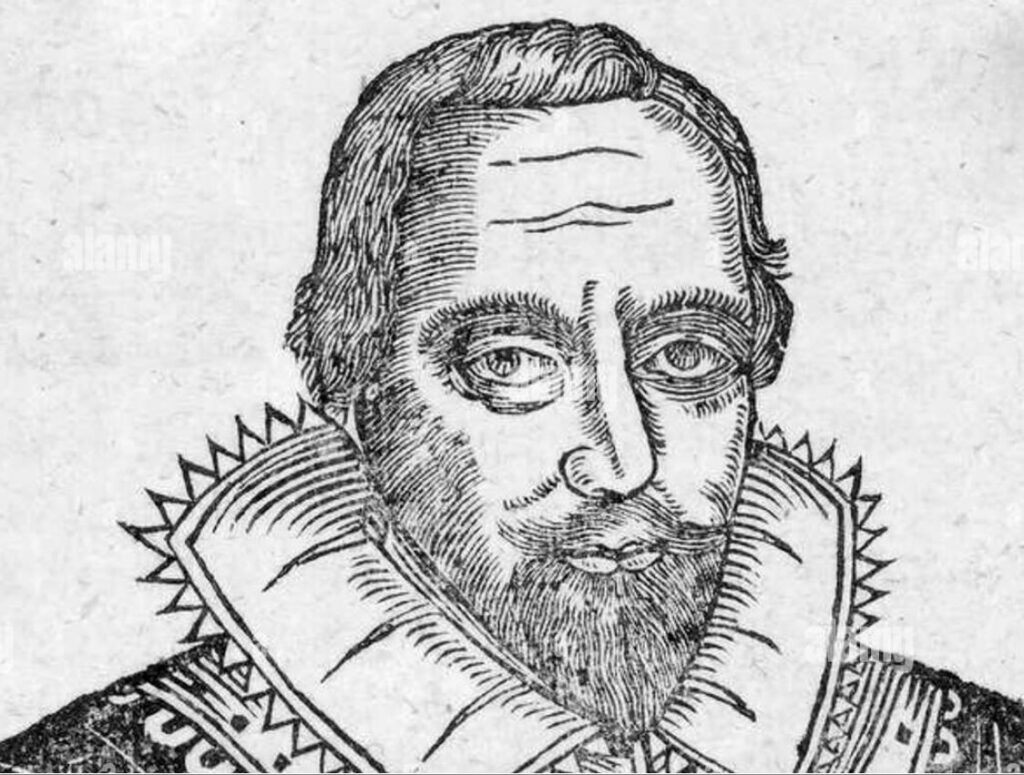
From “Traditions of Glin and its Neighbourhood” by Thomas S. Culhane
“When Pelham in his pursuit of the earl of Desmond was encamped near Shanid castle, a man named Mac Shane approached him and said that he would lead him to the Clounlehard woods, where over four hundred people had fled for safety. Mac Shane, who had been a gallowglass in Desmond’s army, was a man of repellent features and revolting habits. He fell in love with a girl named O’Dowd, who refused to have anything to do with him. When Pelham’s troops, led by Mac Shane, entered the wood they found the people clustered together, kneeling in prayer. When the slaughter began some of the young people fled and escaped.
One of these was Philip Geoghegan….. Philip’s sister, who was married to Hugh Cummane, climbed an ivy-clad tree and escaped detection. She witnessed the merciless slaughter of her friends and relatives, which was all over in a short time. Only one person’s life was spared. That was the O’Dowd girl, whom Mac Shane had taken prisoner. Pelham’s troops soon vacated the woods and pushed on towards Glin. Mac Shane returned a little later, accompanied by his prisoner, and began to search the clothes of the dead. While doing so he laid aside his battle-axe. As he was bending down his prisoner seized the weapon and with one swift blow she clove his skull.”
The victims’ bodies were buried where they fell or in the bog across the road. (Locals say that turf was never cut there again.) For a long while afterwards, the local river Abha Bhán or The White River was known as Abha na gCorp (“The river of corpses”.)
The heroine of the piece
No name is recorded for the O’Dowd girl. She later ‘married Dermot Dore, who also escaped from the carnage. She became a legendary figure and many people in that locality were proud to claim descent from her.’
The O’Dowds were tenants of the Walls of Dunmoylan and lived at Balliston.
From The Annals of the Four Masters:
‘The whole tract of country from Waterford to Lothra, and from Cnamhchoill (a wood close to Tipperary) to the county of Kilkenny, was suffered to remain one surface of weeds and waste… At this period it was commonly said that the lowing of a cow or the whistle of the ploughboy could scarcely be heard from Dun-Caoin to Cashel in Munster.’
Aftermath of The Second Desmond Rebellion
On 10 September 1580, 600 papal troops landed at Smerwick in Kerry to support the rebellion. They were besieged in a fort at Dún an Óir. They surrendered after two days of bombardment and were then massacred. By means of the relentless scorched-earth tactics of the English, who killed animals and razed crops and homes to deprive the Irish of any food or shelter, the rebellion was crushed by mid-1581. By May 1581, most of the minor rebels and FitzGerald allies in Munster and Leinster had accepted Elizabeth I’s offer of a general pardon. John of Desmond was killed north of Cork in early 1582.
The Geraldine earl was pursued by English forces until the end. From 1581 to 1583, his supporters evaded capture in the mountains of Kerry. On 2 November 1583, the earl was hunted down and killed near Tralee in Kerry by the O’Moriarty family and English soldiers from Castle Maine. The clan chief, Maurice, received one thousand pounds of silver and a pension of twenty pounds a year from the English government for Desmond’s head, which was sent to the queen. Desmond’s body was displayed on the walls of Cork.
The failure of the rebellions marked a disastrous decline in the fortunes of the province’s population. Famine and pestilence ravaged the province and (like a few years earlier in the counties of Laois and Offaly) the plantation of Munster was to follow in a few years.
Hindsight:
For some perspective: The population of Ireland in 1600 was one million. (It is now seven million.) Four hundred men, women and children was a large percentage of not only the local Ballyhahill population but most adjoining areas too.
It is difficult to imagine four hundred people seeking refuge in a wood, especially in modern Ireland with 11% forestry. The island was approximately 70% forest in 1580.
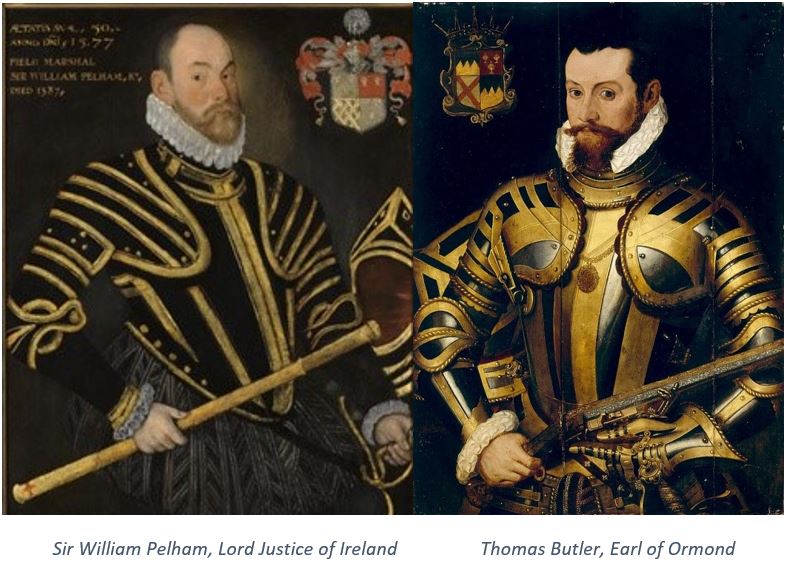
Memorial Plaque, 2024
A plaque and story-board has been erected by a local voluntary group with the common goal of recognising and honouring the many people who were killed and who were sent to their eternal reward in unmarked graves.
It was officially unveiled on 18-Aug-2024.
Committee 2024-2025:
Chairman: Terence McSweeney. Secretary: Councillor John Sheahan.
Treasurer (joint): Packie Hayes, Denis Nolan.
PRO: Brendan Doyle.
Committee: Pat O’Connor, Anthony Halpin, Mike Chawke., John Curtin, Patsy Kenrick, Gary Flavin, James Chawke, Margaret O’Connor, Kathleen Kenrick.
Text of the stone plaque:
Tógadh an leac seo i gcuimhe ar an mbreis is 400 sibhialtach a ndearna Pelham, Fear Ionaid Éibhlís 1, sléacht orthu san áit seo tar éis dóibh teithead ar thóir dídine ón gcogadh a bhí á chur aige ar Iarla Dheasmhumhan sa bhlian 1580.
Erected to the memory of over 400 men, women and children who were massacred by the Elizabethan forces at this location on 12th March 1580 during the Second Desmond Rebellion.
The artwork for the storyboard:
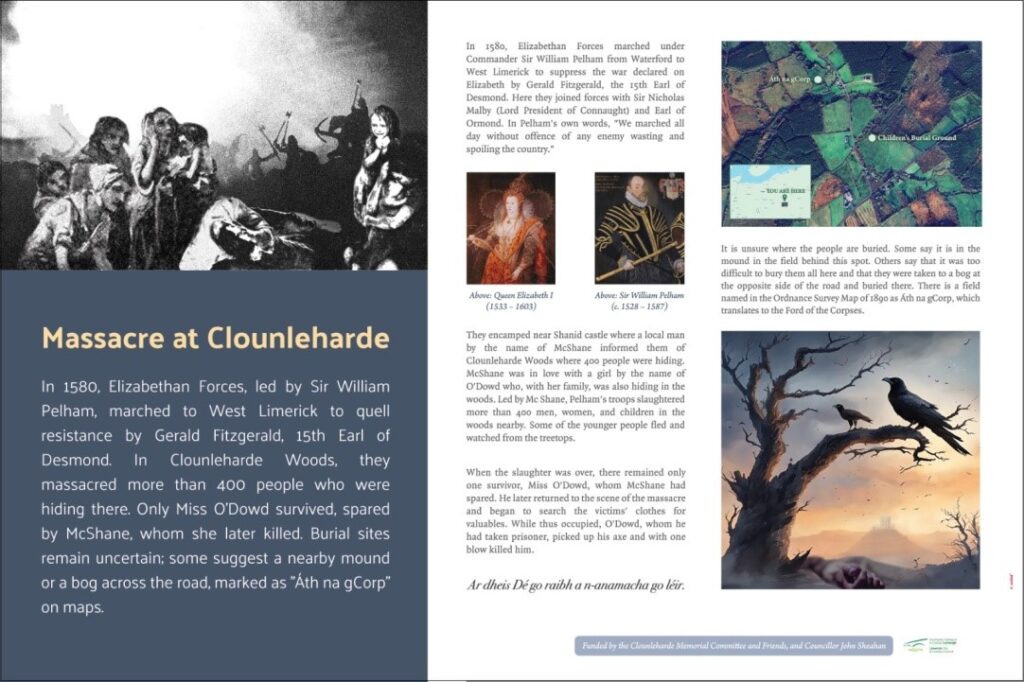
Clounlehard (Cluain Leith Áird)
The townsland, in those times was much larger than at present and comprised the following – Clounlehard East, Clounlehard West, Glenbaun, Knockaclugga, Tooreendonnel, Knockdown, Knocknagornagh, Glashapullagh, Dromagarraun and Tinnakilla.
Map from 1560-1620, Clounlehard at top left.
